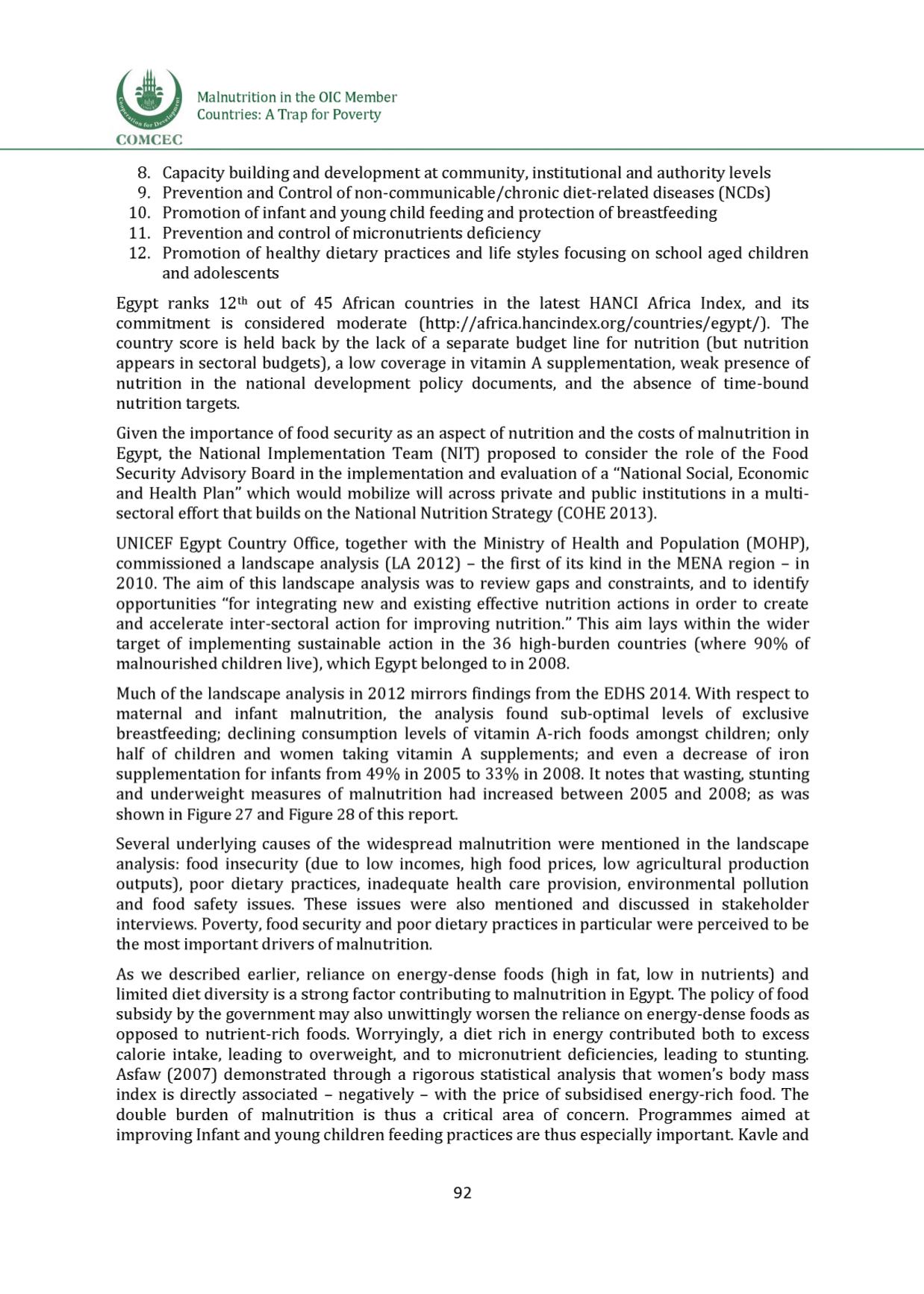

COMCEC
Malnutrition in the OIC Member
Countries: A Trap for Poverty
8
. Capacity building and development at community, institutional and authority levels
9. Prevention and Control of non-communicable/chronic diet-related diseases (NCDs]
10. Promotion of infant and young child feeding and protection of breastfeeding
11. Prevention and control of micronutrients deficiency
12. Promotion of healthy dietary practices and life styles focusing on school aged children
and adolescents
Egypt ranks 12th out of 45 African countries in the latest HANCI Africa Index, and its
commitment is considered moderate
(http://africa.hancindex.org/countries/egypt/]. The
country score is held back by the lack of a separate budget line for nutrition (but nutrition
appears in sectoral budgets], a low coverage in vitamin A supplementation, weak presence of
nutrition in the national development policy documents, and the absence of time-bound
nutrition targets.
Given the importance of food security as an aspect of nutrition and the costs of malnutrition in
Egypt, the National Implementation Team (NIT] proposed to consider the role of the Food
Security Advisory Board in the implementation and evaluation of a “National Social, Economic
and Health Plan” which would mobilize will across private and public institutions in a multi
sectoral effort that builds on the National Nutrition Strategy (COHE 2013].
UNICEF Egypt Country Office, together with the Ministry of Health and Population (MOHP),
commissioned a landscape analysis (LA 2012] - the first of its kind in the MENA region - in
2010. The aim of this landscape analysis was to review gaps and constraints, and to identify
opportunities “for integrating new and existing effective nutrition actions in order to create
and accelerate inter-sectoral action for improving nutrition.” This aim lays within the wider
target of implementing sustainable action in the 36 high-burden countries (where 90% of
malnourished children live], which Egypt belonged to in 2008.
Much of the landscape analysis in 2012 mirrors findings from the EDHS 2014. With respect to
maternal and infant malnutrition, the analysis found sub-optimal levels of exclusive
breastfeeding; declining consumption levels of vitamin A-rich foods amongst children; only
half of children and women taking vitamin A supplements; and even a decrease of iron
supplementation for infants from 49% in 2005 to 33% in 2008. It notes that wasting, stunting
and underweight measures of malnutrition had increased between 2005 and 2008; as was
shown i
n Figure 27 an
d Figure 28 of this report.
Several underlying causes of the widespread malnutrition were mentioned in the landscape
analysis: food insecurity (due to low incomes, high food prices, low agricultural production
outputs], poor dietary practices, inadequate health care provision, environmental pollution
and food safety issues. These issues were also mentioned and discussed in stakeholder
interviews. Poverty, food security and poor dietary practices in particular were perceived to be
the most important drivers of malnutrition.
As we described earlier, reliance on energy-dense foods (high in fat, low in nutrients] and
limited diet diversity is a strong factor contributing to malnutrition in Egypt. The policy of food
subsidy by the government may also unwittingly worsen the reliance on energy-dense foods as
opposed to nutrient-rich foods. Worryingly, a diet rich in energy contributed both to excess
calorie intake, leading to overweight, and to micronutrient deficiencies, leading to stunting.
Asfaw (2007) demonstrated through a rigorous statistical analysis that women's body mass
index is directly associated - negatively - with the price of subsidised energy-rich food. The
double burden of malnutrition is thus a critical area of concern. Programmes aimed at
improving Infant and young children feeding practices are thus especially important. Kavle and
92
















